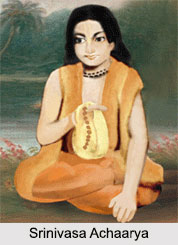 Srinivasa Achrya Thakur was a Vaishnava saint, who was the disciple of Jiva Goswami. The teacher of Yadunandana Dasa and Radhavallabha Dasa, Srinivasa Achrya converted the King Bir Hambir into Vaishnava. His daughter Hemalata Thakurani was also a Vaishnava guru. Srinivasa Acharya, a prasada, is considered to be the "abhinna kalevara" or identical body of Mahaprabhu Chaitanya . According to the legends, Sri Chaitanya continued his works of spreading the message of Vaishnavism through Srinivas Acharya. He was personally invited to come to this earth by Sri Chaitanya. There were two expansions of Sri Chaitanya- the six Goswamis, who discovered the Vrindavan and the expansion of Srinivas Acharya, Narottam Das Thakur and Syamananda Prabhu, who preached the message of Mahaprabhu Chaitanya. The second expansion formed the Sankirtan party; Srinivasa Achrya led the Vaishnava movement and propagated the Krishna Bhakti marg across India.
Srinivasa Achrya Thakur was a Vaishnava saint, who was the disciple of Jiva Goswami. The teacher of Yadunandana Dasa and Radhavallabha Dasa, Srinivasa Achrya converted the King Bir Hambir into Vaishnava. His daughter Hemalata Thakurani was also a Vaishnava guru. Srinivasa Acharya, a prasada, is considered to be the "abhinna kalevara" or identical body of Mahaprabhu Chaitanya . According to the legends, Sri Chaitanya continued his works of spreading the message of Vaishnavism through Srinivas Acharya. He was personally invited to come to this earth by Sri Chaitanya. There were two expansions of Sri Chaitanya- the six Goswamis, who discovered the Vrindavan and the expansion of Srinivas Acharya, Narottam Das Thakur and Syamananda Prabhu, who preached the message of Mahaprabhu Chaitanya. The second expansion formed the Sankirtan party; Srinivasa Achrya led the Vaishnava movement and propagated the Krishna Bhakti marg across India.
Life of Srinivasa Acharya
Srinivasa Acharya was born in 1530 AD in the month of Vaishakh in Chakhandi village of Nadia District. His father was Gangadhara Bhattacharya, who was a Brahmin of Rarhi class. He was preached about Mahaprabhu"s stories and Radha-Krishna"s past times by his father and his mother trained him in Kirtan. Along with that, he also studied grammar, literature and poetic theory from Dhananjaya Vidyavachaspati. Srinivasa was married to Ishwari, daughter of Gopal Chakravarti of Jajigram.
This article is a stub. You can enrich by adding more information to it. Send your Write Up to content@indianetzone.com.









